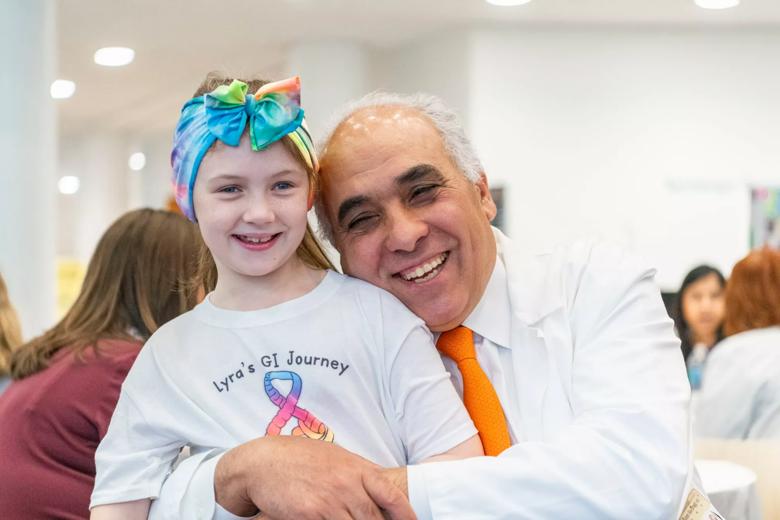More awareness is needed to proactively treat disorder and prevent potential complications
Content is property of Cleveland Clinic and for news media use only.

A Cleveland Clinic study has introduced a new surgical procedure to treat both children and adults with congenital intestinal malrotation, an inherited disorder that can cause the intestines to twist.
The study, published in the Annals of Surgery, also defines the disease presentation in both children and adults, identifies the patients at risk of intestinal loss, and assesses the long-term outcomes after different surgical interventions.
Congenital intestinal malrotation, also known as gut malrotation, can cause the small and large intestines to twist, which potentially can lead to the development of life-threatening complications. The condition, often overlooked or misdiagnosed, can affect people at any age.

Malrotation occurs in about one out of every 500 births in the United States. During pregnancy, a baby’s bowel normally rotates 270-degree counterclockwise and then becomes fixed in position. With gut malrotation, however, this embryonic process is defective and sometimes associated with mal-development of the gut, abdominal wall and the nerve supply of the intestine. As a result, babies, children and adults with the disorder can suffer from several gastrointestinal symptoms – from abdominal pain, nausea and bloating to food intolerance and altered bowel habits. Most seriously, twisted intestines – known as volvulus – often result in loss of most of the small bowel and half of the colon with the need for long-term intravenous nutrition. Some patients may ultimately need life-saving intestinal or multivisceral transplantation.
Drawing on 30 years of experience in digestive surgery and transplantation, Kareem Abu-Elmagd, M.D., Ph.D. — director of Cleveland Clinic’s Center for Gut Rehabilitation and Transplantation and lead author of the study — developed a new gut malrotation correction surgery to alleviate the gastrointestinal symptoms as well as prevent the need for gut transplantation. “During the procedure, the digestive organs are rearranged and fixed in their proper anatomic locations, which prevents the intestines from twisting and resolves the digestive symptoms with improved quality of life,” said Dr. Abu-Elmagd.
The operation that has been used traditionally to address intestinal malrotation is called the Ladd’s procedure, which untwists the intestines and alleviates the bowel obstruction by dividing adhesive bands between the duodenum (upper part of the small intestine) and colon.
However, despite the relief of the obstruction with some temporary improvement in patient’s symptoms, the Ladd’s procedure does not prevent the intestine from recurrent future twisting, which can cut off the blood supply and be life-threatening at any age.
This study is the largest series worldwide with the longest follow-up in the literature.
How “Kareem’s procedure”allowed one patient, 10-year-old Lyra Craighead, to live a normal, healthy life without medications:
Surgery to Reconstruct the Gut Allows Girl With Twisted Intestines to Thrive
Of the 500 study patients, 41% were referred after losing their intestine due to volvulus and the remaining 59% had intact gut with a wide range of digestive symptoms. Gut transplantation was required for patients with massive intestinal loss. The new operation (“Kareem’s procedure”) was performed in patients with intact gut and disabling symptoms.
The study further revealed:
“This study shows the favorable outcomes of gut transplantation in saving the lives of babies with intestinal loss,” said Dr. Abu-Elmagd. “These encouraging results must be shared with parents to guide their decision-making process along with their clinical care team.”
This study also shows that more awareness about intestinal malrotation is needed to proactively treat the disorder and prevent its potentially life-threatening complications.
“Overlooked symptoms or misdiagnosis can result in a delay to receive life-changing care,” said Dr. Abu-Elmagd. “Therefore, it is important to diagnose the congenital disorder early in life – possibly with increased efforts to establish perinatal screening programs – so patients can receive an effective surgical treatment in a timely manner to prevent volvulus and save their gut.”
In this study, the Kareem’s procedure was performed on 80 patients with intact gut and disabling symptoms – 92% were adults and 8% were children. Soon after surgery, the digestive symptoms improved significantly. With up to 10 years of follow-up, most of those patients are able to eat normally and have a better quality of life. None of the patients developed volvulus following the Kareem’s procedure.
“The new operation is safe and effective, and can be performed in patients of all ages with intestinal malrotation, especially in the presence of disabling symptoms and those who had volvulus after Ladd’s,” said Dr. Abu-Elmagd. “It is my hope that this procedure can become part of the surgical training for both pediatric and adult surgeons.”
A feasibility study evaluating a laparoscopic approach to safely perform the procedure is currently underway at Cleveland Clinic.
Cleveland Clinic is a nonprofit multispecialty academic medical center that integrates clinical and hospital care with research and education. Located in Cleveland, Ohio, it was founded in 1921 by four renowned physicians with a vision of providing outstanding patient care based upon the principles of cooperation, compassion and innovation. Cleveland Clinic has pioneered many medical breakthroughs, including coronary artery bypass surgery and the first face transplant in the United States. Cleveland Clinic is consistently recognized in the U.S. and throughout the world for its expertise and care. Among Cleveland Clinic’s 82,600 employees worldwide are more than 5,786 salaried physicians and researchers, and 20,700 registered nurses and advanced practice providers, representing 140 medical specialties and subspecialties. Cleveland Clinic is a 6,728-bed health system that includes a 173-acre main campus near downtown Cleveland, 23 hospitals, 280 outpatient facilities, including locations in northeast Ohio; Florida; Las Vegas, Nevada; Toronto, Canada; Abu Dhabi, UAE; and London, England. In 2024, there were 15.7 million outpatient encounters, 333,000 hospital admissions and observations, and 320,000 surgeries and procedures throughout Cleveland Clinic’s health system. Patients came for treatment from every state and 112 countries. Visit us at clevelandclinic.org. Follow us at x.com/CleClinicNews. News and resources are available at newsroom.clevelandclinic.org.
Editor’s Note: Cleveland Clinic News Service is available to provide broadcast-quality interviews and B-roll upon request.